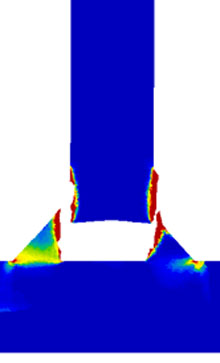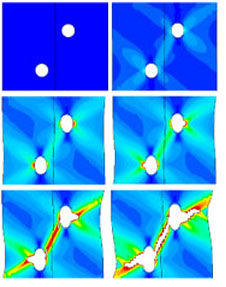Damage Mechanics
Zebulon offers the largest variety of damage mechanics related options of any commercial FEA software. Features include crack integrals (J, delta J, etc), crack growth boundary conditions and debonding interfaces with contact activation, continuum damage mechanics, and new developments arriving for non-local solutions.
 This is a calculation of crack growth using a maximum crack tip
strain criterion. notice the change in crack opening angle as
the growth accelerates towards failure. Implicit dynamic solutions
can be helpful for this type of analysis to prevent numerically
related instability creating run away growth.
This is a calculation of crack growth using a maximum crack tip
strain criterion. notice the change in crack opening angle as
the growth accelerates towards failure. Implicit dynamic solutions
can be helpful for this type of analysis to prevent numerically
related instability creating run away growth.
 This is a weld fracture using the Gurson porous plastic behavior.
The failure was calculated to completion in 290 loading increments.
This is a plot of the cumulated plastic strain using Gauss point
plots (exact values). The loading was vertical tension and
horizontal to the right side.
This is a weld fracture using the Gurson porous plastic behavior.
The failure was calculated to completion in 290 loading increments.
This is a plot of the cumulated plastic strain using Gauss point
plots (exact values). The loading was vertical tension and
horizontal to the right side.
 This is a simulation of void coalescence in a ductile material
(Gurson model). Again, damage is calculated to total failure.
Note the interesting symmetry MPC which was imposed. The mesh
for this calculation is extremely fine, so the calculation was
run on an IBM SP2 supercomputer.
This is a simulation of void coalescence in a ductile material
(Gurson model). Again, damage is calculated to total failure.
Note the interesting symmetry MPC which was imposed. The mesh
for this calculation is extremely fine, so the calculation was
run on an IBM SP2 supercomputer.
 New cutting edge anisotropic damage models with anisotropic
viscoplasticity are under development. This figure shows several different
stages. The first non-linearity is the onset of damage, followed by a
distinct yielding. Load reversal shows a reduced modulus, and reversed
yielding with kinematic hardening. As the stress becomes more negative
a "fiber-closure" mechanism is reached (stiffining the material), but
the damage still exists so another reversal has a point above which the
modulus is still reduced.
New cutting edge anisotropic damage models with anisotropic
viscoplasticity are under development. This figure shows several different
stages. The first non-linearity is the onset of damage, followed by a
distinct yielding. Load reversal shows a reduced modulus, and reversed
yielding with kinematic hardening. As the stress becomes more negative
a "fiber-closure" mechanism is reached (stiffining the material), but
the damage still exists so another reversal has a point above which the
modulus is still reduced.